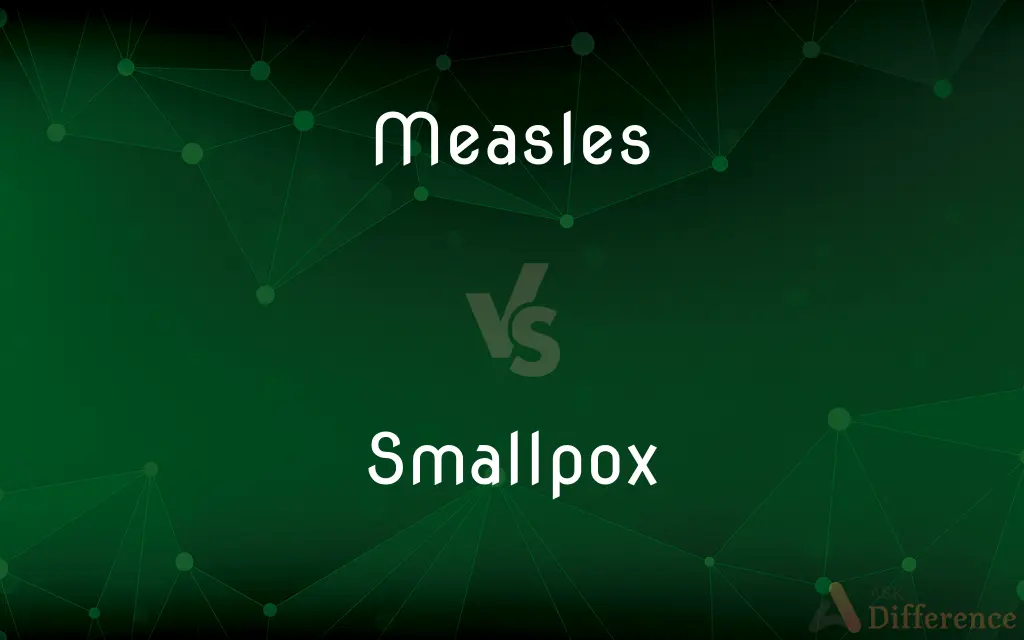Measles vs. Smallpox — What's the Difference?
By Tayyaba Rehman & Maham Liaqat — Updated on March 13, 2024
Measles, a highly contagious viral disease with fever and rash, contrasts with smallpox, a severe, pustular disease eradicated in 1980.

Difference Between Measles and Smallpox
Table of Contents
ADVERTISEMENT
Key Differences
Measles, caused by the rubeola virus, primarily affects children and is marked by fever and a distinctive rash. Whereas smallpox, caused by the variola virus, was known for its severe symptoms, including a unique pustular rash and high mortality rate, before its eradication.
Both diseases can be prevented through vaccination, yet measles vaccinations are still widely administered globally due to its prevalence, on the other hand, smallpox vaccinations ceased after the disease was eradicated.
Measles is characterized by symptoms such as cough, runny nose, and inflamed eyes, followed by a rash. Smallpox, in contrast, began with high fever and malaise, and then progressed to a rash that developed into pus-filled sores.
Complications from measles can include pneumonia and encephalitis, while smallpox could lead to severe scarring, blindness, and death, indicating its higher severity.
Measles can be seen worldwide, with outbreaks occurring in areas with low vaccination rates, smallpox has no natural occurrences since its eradication, highlighting the success of global vaccination campaigns against it.
ADVERTISEMENT
Comparison Chart
Cause
Rubeola virus
Variola virus
Symptoms
Fever, cough, runny nose, inflamed eyes, rash
High fever, malaise, rash, pus-filled sores
Complications
Pneumonia, encephalitis
Scarring, blindness, death
Vaccination
Still required
Stopped after eradication
Prevalence
Global, with outbreaks
Eradicated in 1980
Compare with Definitions
Measles
Highly contagious viral infection.
Measles spreads through coughing and sneezing.
Smallpox
Had a high mortality rate.
Smallpox had a mortality rate of up to 30% in unvaccinated individuals.
Measles
Characterized by fever, rash, cough, and conjunctivitis.
The measles rash usually appears several days after the fever.
Smallpox
No natural occurrences since eradication.
There have been no natural cases of smallpox since its eradication.
Measles
Vaccination available and recommended.
Children typically receive the measles vaccine as part of the MMR shot.
Smallpox
Eradicated viral disease.
Smallpox was declared eradicated by the WHO in 1980.
Measles
Outbreaks occur in unvaccinated populations.
Measles outbreaks often happen in communities with low vaccination rates.
Smallpox
Vaccination ceased after eradication.
Routine smallpox vaccination stopped after the disease was eradicated.
Measles
Can lead to serious complications.
Complications from measles can include pneumonia and encephalitis.
Smallpox
Characterized by fever and a progressive skin rash.
Smallpox caused a distinctive pustular rash and scarring.
Measles
Measles is a highly contagious infectious disease caused by measles virus. Symptoms usually develop 10–12 days after exposure to an infected person and last 7–10 days.
Smallpox
Smallpox was an infectious disease caused by one of two virus variants, Variola major and Variola minor. The agent of variola virus (VARV) belongs to the genus Orthopoxvirus.
Measles
An acute, contagious viral disease, usually occurring in childhood and characterized by eruption of red spots on the skin, fever, and catarrhal symptoms. Also called rubeola.
Smallpox
An acute, highly infectious, often fatal disease caused by a poxvirus and characterized by high fever and aches with subsequent widespread eruption of pimples that blister, produce pus, and form pockmarks. Smallpox was eradicated worldwide by 1979 as a result of numerous vaccination campaigns and the virus exists only as a laboratory specimen. Also called variola.
Measles
Black measles.
Smallpox
(disease) An acute, highly infectious often fatal disease caused by Variola virus of the family Poxviridae. It was completely eradicated in the 1970s, but still exists in laboratories. Those who survived were left with pockmarks.
The Europeans brought new diseases such as smallpox, measles, dysentery, influenza, syphilis and leprosy.
Measles
Any of several other diseases, especially German measles, that cause similar but milder symptoms.
Smallpox
A contagious, constitutional, febrile disease characterized by a peculiar eruption; variola. The cutaneous eruption is at first a collection of papules which become vesicles (first flat, subsequently umbilicated) and then pustules, and finally thick crusts which slough after a certain time, often leaving a pit, or scar.
Measles
A condition of pork or beef caused by the presence of tapeworm larvae.
Smallpox
A highly contagious viral disease characterized by fever and weakness and skin eruption with pustules that form scabs that slough off leaving scars
Measles
A plant disease, usually caused by fungi, that produces small spots on leaves, stems, or fruit.
Measles
(medicine) An acute and highly contagious disease which often afflicts children caused by the virus Measles morbillivirus and causing red rashes, fever, runny nose, coughing, and red eyes.
Measles
Any disease causing red rashes.
Measles
(obsolete) Used as an intensifier.
Measles
(veterinary medicine) cysticercosis: A disease of livestock or meat caused by the presence of tapeworm larvae.
Measles
Any disease causing a tree's bark to become rough and irregular.
Measles
(medicine) measle: a red spot forming part of a rash, (now) particularly those caused by M. morbillivirus.
Measles
(figuratively) measle: any similar-looking red spot, particularly (printing) foxing.
Measles
(veterinary medicine) measle: the individual cysts of cysticercosis.
Measles
Plural of measle: the individual blisters in the surface of a diseased tree's bark.
Measles
A discreet assassination made to look like death from any natural cause.
Measles
(obsolete) measle
Measles
(obsolete) mesels: Leprosy.
Measles
Leprosy; also, a leper.
Measles
A contagious viral febrile disorder commencing with catarrhal symptoms, and marked by the appearance on the third day of an eruption of distinct red circular spots, which coalesce in a crescentic form, are slightly raised above the surface, and after the fourth day of the eruption gradually decline; rubeola. It is a common childhood disease.
Measles commences with the ordinary symptoms of fever.
Measles
A disease of cattle and swine in which the flesh is filled with the embryos of different varieties of the tapeworm.
Measles
A disease of trees.
Measles
The larvæ of any tapeworm (Tænia) in the cysticerus stage, when contained in meat. Called also bladder worms.
Measles
An acute and highly contagious viral disease marked by distinct red spots followed by a rash; occurs primarily in children
Common Curiosities
Can measles and smallpox be prevented?
Yes, both can be prevented through vaccination.
Is the measles vaccine still necessary?
Yes, due to ongoing global measles outbreaks.
How are measles and smallpox transmitted?
Measles spreads through respiratory droplets, while smallpox was transmitted through direct contact and respiratory droplets.
What causes smallpox?
Smallpox was caused by the variola virus.
What are the complications associated with measles?
Complications can include pneumonia and encephalitis.
What causes measles?
Measles is caused by the rubeola virus.
What are the symptoms of measles?
Symptoms include fever, cough, runny nose, inflamed eyes, and rash.
What were the symptoms of smallpox?
Symptoms included high fever, malaise, and a distinct pustular rash.
What were the complications associated with smallpox?
Complications included severe scarring, blindness, and death.
Can measles lead to death?
Yes, especially in young children and adults with complications.
Are measles outbreaks still common?
Yes, measles outbreaks occur, especially in areas with low vaccination coverage.
How did smallpox affect human history?
Smallpox had a significant impact, causing millions of deaths before its eradication.
How was smallpox eradicated?
Through a global vaccination campaign led by the World Health Organization.
Why has smallpox vaccination stopped?
Smallpox vaccination ceased after the disease was eradicated.
How effective is the measles vaccine?
The measles vaccine is highly effective and provides long-lasting immunity.
Share Your Discovery

Previous Comparison
Entrepreneurship vs. Intrapreneurship
Next Comparison
Percher vs. SoulAuthor Spotlight
Written by
Tayyaba RehmanTayyaba Rehman is a distinguished writer, currently serving as a primary contributor to askdifference.com. As a researcher in semantics and etymology, Tayyaba's passion for the complexity of languages and their distinctions has found a perfect home on the platform. Tayyaba delves into the intricacies of language, distinguishing between commonly confused words and phrases, thereby providing clarity for readers worldwide.
Co-written by
Maham Liaqat















































